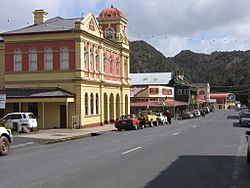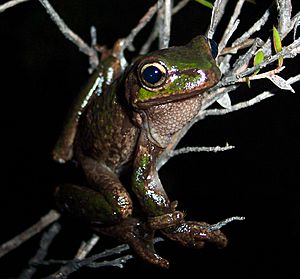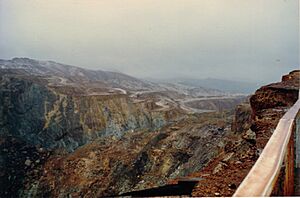Queenstown, Tasmania facts for kids
Quick facts for kids QueenstownTasmania |
|||||||||
|---|---|---|---|---|---|---|---|---|---|

Orr Street, from centre, looking west
|
|||||||||
| Population | 1,808 (2021 census) | ||||||||
| Postcode(s) | 7467 | ||||||||
| Elevation | 129 m (423 ft) | ||||||||
| Location | |||||||||
| LGA(s) | West Coast Council | ||||||||
| State electorate(s) | Braddon | ||||||||
| Federal Division(s) | Braddon | ||||||||
|
|||||||||
Queenstown is a small town located in the West Coast area of Tasmania, an island state in Australia. It sits in a valley on the western side of Mount Owen, which is part of the West Coast Range.
In 2021, about 1,808 people lived in Queenstown. This town has a long and interesting history, especially linked to mining.
Contents
Discovering Queenstown's Past: A Mining Story
Queenstown's story is closely connected to the mining industry. People first explored this mountainous area in 1862. Soon after, they found gold at Mount Lyell. This led to the creation of the Mount Lyell Gold Mining Company in 1881.
By 1892, the company started looking for copper instead of gold. The company later became known as the Mount Lyell Mining and Railway Company.
How Queenstown Grew: From Penghana to Today
In early 1895, a Post Office opened in a nearby place called Penghana. This was about a kilometer north of where Queenstown is now. The Queenstown Post Office officially opened on November 21, 1896. The Penghana office then closed down.
The current Queenstown Post Office building was built in 1902 and is now a protected heritage site. The name "Penghana" is still used for a road nearby.
Queenstown's Busy Days: A Mining Hub
In the early 1900s, Queenstown was a very busy place. It was the main center for the Mount Lyell mining area. There were many factories for smelting (melting metal), making bricks, and sawmills. The area used to have lots of trees.
In 1900, Queenstown had a population of 5,051 people. The wider district had 10,451 people. The town was the base for the Queenstown Council until the 1990s. Back then, Queenstown had many hotels, theaters, churches, and schools. Most of these have disappeared since the Mount Lyell company became smaller.
Building Dams and Protecting Nature
In the 1980s, Queenstown saw a short period of growth. This was because the Hydro company built several dams nearby. The Darwin and Crotty dams created Lake Burbury, which is now a popular spot for fishing and fun.
These dams were built after a big environmental campaign in 1983. People protested against the planned Gordon-below-Franklin Dam. The protests were successful, and the dam was cancelled.
Understanding Queenstown's Unique Environment
The mountains around Queenstown look very special. They have unusual pink and grey colors. These colors come from the types of rocks found on Mount Lyell and Mount Owen. In winter, these mountains are often covered in snow. Snow usually falls a few days each year.
For about 40 years, trees were cut down for the smelters, and fumes from the smelters also caused damage. This, along with heavy rainfall, led to the soil washing away. This is why the mountains looked so bare for many decades.
Nature's Slow Comeback: Replanting Efforts
In Western Tasmania, after fires, small shrubs often start to grow back first. This is a very early stage of a long recovery for the plants and animals in the area.
Some people in the 1980s worried that new plants might hide the bare, "moonscape" look of parts of Mount Lyell and Mount Owen. Even though large areas still can't grow plants because of steep slopes and no soil, efforts to replant have been difficult.
For most of the Mount Lyell company's history, the Queen River received waste from the mines and the town's sewage. This waste then flowed into the King River and finally into Macquarie Harbour.
Now, thanks to the Mount Lyell Remediation and Research and Demonstration Program, mining waste and local sewage no longer flow directly into the rivers.
Queenstown Today: A Tourist Hotspot

Today, Queenstown attracts many tourists. Visitors come on organized tours or drive around Tasmania in rental cars. The grand Empire Hotel looks over the steam train station. From here, you can take rides through thick rainforest to the nearby town of Strahan.
New mountain bike trails and white water rafting trips are helping the town grow as a tourist spot. Some older features still interest tourists, like the mountains, the old slag heap (waste from mining), and the unique gravel football ground. You can learn a lot about the town's past at the local museum. Just driving up Orr Street, the old main street, you can see the impressive Post Office tower.
Mining Continues and New Discoveries
Mining still happens at the original Mount Lyell mine. Copper Mines of Tasmania operated it for a while. Then, it became part of an Indian company group. The mined materials are sent to India for processing. In 2021, the Indian company Vedanta Limited sold its copper mining operations in Queenstown.
People are still exploring the West Coast region for more valuable minerals. Because the geology is so complex, new mines might open in the future. The Henty Gold Mine, which started in the 1990s, is a good example of a newer discovery.
Queenstown is also the end point of the West Coast Wilderness Railway. This train travels south along the Queen River and then along the northern slopes of the King River. It ends at the port of Strahan in Macquarie Harbour.
Celebrating Queenstown's Heritage: The Unconformity Festival
The Queenstown Heritage and Arts Festival was the first name for a festival that happens every two years. It celebrates Queenstown's rich history.
One important historical event it celebrated was 100 years since the 1912 North Mount Lyell Disaster. This was at the second festival in October 2012. At the third festival in October 2014, the 100th anniversary of Hydro Tasmania was a big part of the event.
With key events taking place at The Paragon Theatre, the festival changed its name to the Unconformity Festival in 2016.
Queenstown's Weather: A Wet and Wild Climate
Queenstown has a very wet oceanic climate (called Cfb by scientists). It is one of the wettest places in Tasmania. On average, it gets about 2408.2 millimeters (94.8 inches) of rain each year. Rain falls throughout the year, but especially in winter.
Summers are cool to mild, and cold fronts from the Roaring Forties (strong winds) can happen. However, temperatures can sometimes go above 30 °C. Winters are cool to cold and almost always cloudy. But during rare clear nights, temperatures can drop well below freezing. Light snow usually falls a few times each winter, and heavier snow happens every few years. Queenstown is very cloudy, with only about 29 clear days each year.
| Climate data for Queenstown (7XS, 1964–1995); 129 m AMSL; 42.10° S, 145.54° E | |||||||||||||
|---|---|---|---|---|---|---|---|---|---|---|---|---|---|
| Month | Jan | Feb | Mar | Apr | May | Jun | Jul | Aug | Sep | Oct | Nov | Dec | Year |
| Record high °C (°F) | 37.3 (99.1) |
36.3 (97.3) |
35.9 (96.6) |
29.5 (85.1) |
25.0 (77.0) |
19.5 (67.1) |
19.5 (67.1) |
21.0 (69.8) |
26.4 (79.5) |
29.0 (84.2) |
33.3 (91.9) |
35.3 (95.5) |
37.3 (99.1) |
| Mean daily maximum °C (°F) | 21.0 (69.8) |
22.0 (71.6) |
19.9 (67.8) |
16.6 (61.9) |
14.4 (57.9) |
12.2 (54.0) |
11.6 (52.9) |
12.4 (54.3) |
13.5 (56.3) |
15.9 (60.6) |
17.6 (63.7) |
19.3 (66.7) |
16.4 (61.5) |
| Mean daily minimum °C (°F) | 8.3 (46.9) |
8.6 (47.5) |
7.6 (45.7) |
6.5 (43.7) |
4.5 (40.1) |
2.7 (36.9) |
2.4 (36.3) |
3.1 (37.6) |
4.0 (39.2) |
5.1 (41.2) |
6.4 (43.5) |
7.9 (46.2) |
5.6 (42.1) |
| Record low °C (°F) | 0.0 (32.0) |
0.0 (32.0) |
−1.1 (30.0) |
−2.6 (27.3) |
−6.0 (21.2) |
−6.2 (20.8) |
−6.7 (19.9) |
−5.5 (22.1) |
−3.9 (25.0) |
−3.3 (26.1) |
−1.5 (29.3) |
−0.6 (30.9) |
−6.7 (19.9) |
| Average rainfall mm (inches) | 149.9 (5.90) |
98.8 (3.89) |
147.2 (5.80) |
211.3 (8.32) |
241.4 (9.50) |
212.7 (8.37) |
268.6 (10.57) |
267.5 (10.53) |
248.5 (9.78) |
209.9 (8.26) |
183.7 (7.23) |
168.7 (6.64) |
2,408.2 (94.79) |
| Average rainy days (≥ 0.2mm) | 17.2 | 12.9 | 17.3 | 20.6 | 21.2 | 19.9 | 23.7 | 24.6 | 23.1 | 21.7 | 19.7 | 18.6 | 240.5 |
| Average afternoon relative humidity (%) | 60 | 60 | 65 | 72 | 76 | 77 | 77 | 73 | 71 | 64 | 63 | 63 | 68 |
| Source: Bureau of Meteorology | |||||||||||||
Who Lives in Queenstown: Demographics
In 2021, Queenstown had 1,808 people living there. There were 929 males and 878 females. The average age was 47 years old. About 15.3% of the population were children aged 0–14 years. People aged 65 and over made up 22.3% of the population.
When asked about religion in 2021, most people in Queenstown said they had No Religion (40.5%). Other common responses were Catholic (22.0%), Anglican (16.7%), and Uniting Church (3.1%). Aboriginal and Torres Strait Islander people made up 6.7% of the population.
The average weekly income for people aged 15 and over in Queenstown was $509. For families, the average weekly income was $1,371, and for households, it was $851.
Panorama
Gallery
See also
 In Spanish: Queenstown (Tasmania) para niños
In Spanish: Queenstown (Tasmania) para niños





